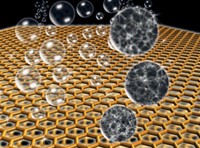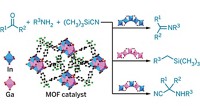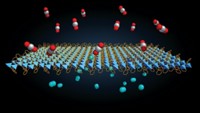Advertisement
Grab your lab coat. Let's get started
Welcome!
Welcome!
Create an account below to get 6 C&EN articles per month, receive newsletters and more - all free.
It seems this is your first time logging in online. Please enter the following information to continue.
As an ACS member you automatically get access to this site. All we need is few more details to create your reading experience.
Not you? Sign in with a different account.
Not you? Sign in with a different account.
ERROR 1
ERROR 1
ERROR 2
ERROR 2
ERROR 2
ERROR 2
ERROR 2
Password and Confirm password must match.
If you have an ACS member number, please enter it here so we can link this account to your membership. (optional)
ERROR 2
ACS values your privacy. By submitting your information, you are gaining access to C&EN and subscribing to our weekly newsletter. We use the information you provide to make your reading experience better, and we will never sell your data to third party members.
Materials
Living in the Materials World
Annual meeting draws record-sized crowd for wide-ranging discussions on materials research
by Mitch Jacoby
January 5, 2004
| A version of this story appeared in
Volume 82, Issue 1

From biomaterials to batteries and semiconductors to supramolecular assemblies, materials enthusiasts were treated to a smorgasbord of research presentations last month at the Materials Research Society annual fall meeting in Boston. Chemists, physicists, biologists, engineers, and, of course, materials scientists were among nearly 5,000 people who traveled from more than 40 countries to catch the latest research news. With 40 symposia and well over 4,000 technical presentations, this year's meeting, which according to MRS officials drew a record-setting crowd, offered something for everyone.
In a symposium covering nanostructured organic materials, for example, Federico Rosei described experiments in which organic molecules serve as microscopic molds that stamp unique nanometer-sized shapes and patterns on metal surfaces. Rosei, a professor in the department of energy, materials, and telecommunications at the University of Quebec, Varennes, noted that surface-molding techniques could play a role in molecular electronics applications by forming interconnects between molecules and electrodes.
In one set of experiments, Rosei and coworkers in the research group of Flemming Besenbacher, a physics professor at the University of Aarhus, in Denmark, where Rosei conducted postdoctoral research, used a scanning tunneling microscope (STM) to manipulate and image C90H98 molecules on a copper crystal. Synthesized by chemists in Toulouse, France, the compound--nicknamed "the Lander" because of its resemblance to a Mars surface rover--consists of a polyaromatic "body" and four 3,5-di-tert-butylphenyl spacer "legs" that lift the body slightly above the surface.

Using the STM tip, the group gently moved aside some of the molecules and found that the surface had been restructured. Specifically, Rosei and coworkers observed that the Lander molecules had trapped a number of copper atoms in the small space beneath each molecule's body. Rosei explained that at room temperature, copper atoms in the vicinity of steps and other types of crystal irregularities ordinarily are quite mobile. But in the presence of the organic molecules, the diffusing atoms are immobilized.
By exposing the copper surface to the organic molecules at room temperature and then cooling the crystal, the group was able to move aside the molecules and examine the surface beneath them. Surprisingly, they found that the surface had been patterned with copper structures just two atoms wide and seven atoms long--matching the size and shape of the "underside" of the Lander molecules.
If a 90-carbon molecule can be used to stamp a two-atom by seven-atom shape on a metal surface, then perhaps custom patterns can be prepared using tailor-made organic molds. That's the reasoning Rosei and coworkers followed in a more recent round of experiments in which they studied the surface-restructuring effects of a related molecule--C108H104 (dubbed "Violet Lander" due to the material's color).
THE STRUCTURES of the two Lander molecules are quite similar. The principal difference is that the "body" of the C108 compound is 0.8 nm longer than the smaller molecule; also, its aromatic rings are arranged somewhat differently. Using the same types of STM techniques, Rosei and coworkers found that, just like its smaller counterpart, the larger molecule also traps diffusing copper atoms. This time, the patterns were found to be nine atoms long and two atoms wide--although some three-atom-wide structures were also observed [Nano Lett., published online Nov. 26, http://dx.doi.org/10.1021/nl0348793].
"It's just like using plastic sand toys at the beach," Rosei remarked. Use a bigger mold, and you form a bigger sandcastle. "The fascinating thing is that we're doing it on the nanometer scale," he said.

While some organic molecules exert their influence on metal surfaces, others affect their fellow molecules. Benjamin W. Messmore reported on triblock molecules containing oligothiophene segments that self-assemble into elongated structures due to intermolecular attractions. Messmore is a Northwestern University graduate student who works in the research group of Samuel I. Stupp, a professor of materials science, chemistry, and medicine.
Because of their stability and capacity for accommodating charge carriers, oligothiophene-based systems are being investigated by the Northwestern team and other research groups as candidate materials for fabricating organic field-effect transistors, light-emitting diodes, and other "plastic" electronic components.
Messmore's triblock compound, the product of a multistep synthesis, consists of a dendritic dihydroxybenzoic ester unit, a substituted tetrathiophene phenol rod segment, and a branched alkane coil. The Northwestern student noted that, because of the unique wedge shape of the molecule, the material self-assembles into one-dimensional structures. Hydrogen-bonding between dendron aromatic units and electronic interactions among the thiophene rods (p-stacking) drive the triblock molecules to assemble into polymeric-type ribbon structures.
The assembly process depends upon the solvent. In poor solvents, such as toluene, the molecules assemble, causing the solutions to gel. In contrast, the material remains well solvated in good solvents, such as tetrahydrofuran (THF).
To study the effects of the assembly process on the material's properties, Messmore and graduate student James F. Hulvat subjected the specimens to a number of tests. They found, for example, that the self-assembled (gelled) material's absorption and emission spectra are red-shifted relative to solution-phase samples. And fluorescence is quenched in the gels compared with THF solutions.
From X-ray measurements and atomic force microscopy analysis, the group observed that the dendron-rod-coil molecules do indeed form 1-D structures. And electrical measurements show 1,000-fold greater conductivity in films cast from gelled toluene solutions than in films from THF solutions. In addition, the group found that they can align the ribbon structures by applying an alternating electric field to the solutions while evaporating the solvent.
Unlike triblock molecules that assemble into 1-D structures, hydrocarbons with nanometer-sized diamond lattices come in an assortment of 3-D structures. In addition to adamantane, which is used commercially, some of the simpler members of this family of diamondoid molecules, including diamantane, triamantane, and one of the tetramantanes, have been synthesized but aren't widely available due to the high cost of production. But none of the higher diamondoids were available synthetically or from natural sources until about one year ago, when a team of chemists at MolecularDiamond Technologies, a new business unit of ChevronTexaco, including Shenggao Liu, reported isolating and crystallizing many of the compounds from petroleum sources (C&EN, Dec. 2, 2002, page 13).
At the MRS conference, Liu noted that the novel materials hold promise for pharmaceutical applications, custom chemicals and polymers, and nanotechnology. 1-Aminoadamantane is used currently in pharmaceutical applications as an antiviral drug and in the treatment of Parkinson's disease. The ChevronTexaco team is working to promote additional applications of the cage compounds by developing new techniques for producing, purifying, and derivatizing them.
Highlighting the group's recent successes in those areas, Liu reported that the team has developed methods for preparing diamantane, triamantane, and tetramantane in kilogram quantities. They have also developed chiral chromatography techniques for separating racemic mixtures of [123]tetramantane and have solved the crystal structures of the enantiomers, Liu announced.
Now, the ChevronTexaco chemists are studying derivatization reactions. Liu hinted at the large number of nucleophilic and electrophilic substitution reactions being studied by ChevronTexaco but showed GC-MS data from just a few simple reactions, including brominations, hydroxylations, and aminations of tetramantanes.
Sharing the stage with their organic counterparts, nanostructured inorganic materials and semiconductors were also featured in several symposia. In one example, Joshua Goldberger, a graduate student working with chemistry professor Peidong Yang at the University of California, Berkeley, presented his group's work on single-crystal gallium nitride nanotubes.
Displaying striking micrographs, Goldberger described a new procedure developed by the Berkeley group in which zinc oxide nanowires are used as templates to prepare gallium nitride nanotubes. The first step calls for growing arrays of ZnO nanowires on a solid substrate, such as alumina, using a technique developed by Yang's group a few years ago. Then the group coats the ZnO nanowires with GaN using trimethylgallium and ammonia in a chemical vapor deposition method. In the final step, the core of the coated wires is etched away by treating the composite materials with hydrogen or ammonia at high temperature [Nature, 422, 599 (2003)].
THE KEYS to the technique's success, Goldberger explained, are the similarities in crystal symmetry and close match in lattice parameters between GaN and ZnO. Those properties promote epitaxial growth of a GaN shell, which was shown to be single crystalline based on electron diffraction measurements. Overall, the method produces hollow GaN nanotubes with inner diameters of 30 to 200 nm and wall thicknesses between 5 and 50 nm.

Goldberger pointed out that his group's new materials are robust and may be incorporated in future applications in nanoscale electronic components, optoelectronics, and biochemical sensing. He added that recently the group has been investigating ways in which the nanotubes can be used in field-effect transistors and nanoscale fluidic devices.
Although various types of nanostructures and other "nano" topics were the focus of lively symposia and coffee-break discussions, there was more to the MRS meeting than nanoscience. In a session on hydrogen storage materials, for example, Gert Wolf, a professor in the Physical Chemistry Institute at the Technical University of Freiberg, in Germany, reported on the properties of borazane (BH3NH3), which he labeled "a promising hydrogen source."
Wolf pointed out that borazane is a stable, nontoxic solid with a high hydrogen content. Several methods are available for preparing the compound--for example, reaction between lithium borohydride and ammonium chloride. But for laboratory preparation, Wolf noted that he prefers the "safe and simple reaction" between ammonium carbonate and sodium borohydride. He also noted that hydrogen can be released from the material in quantities on the order of 15% by mass either through direct thermal decomposition of the solid or via catalytic decomposition of aqueous borazane solutions. These properties and others make the material attractive to automobile manufacturers, such as Opel and General Motors, that support Wolf's research program as part of an overall effort to find suitable methods for providing hydrogen to fuel-cell-powered cars.
To evaluate borazane's usefulness as a hydrogen source, Wolf and coworkers examined the material's properties using various methods including calorimetry and spectroscopy techniques. They found that the solid decomposes readily at fairly low temperatures (below 100 °C), releasing 2.2 moles of H2 per mole of borazane. They also found that the gas phase above the decomposing solid contains aminoborane (BH2NH2) and borazine (BHNH)3, a boron-nitrogen analog of benzene. And based on related studies, Wolf reported that large quantities of hydrogen can be released from aqueous solutions using platinum, palladium, and other metal catalysts and by acidifying the solutions.
Over the years, many metal hydrides and other materials have been investigated as hydrogen-storage compounds, Wolf commented. "But borazane is an unusual and useful compound that seems to have been forgotten in recent times," he remarked. Currently, the Freiberg team is focusing on methods for regenerating the spent material.
The large assortment of discussion topics presented under the heading "materials research" aptly reflects the breadth of the field. Whether the focus is applied research or basic science, scholarly journals are filled with advances in new materials that pour in daily from researchers who work in departments with labels such as chemistry, physics, biology, and engineering. For many of the MRS conference-goers, the labels are unnecessary. To them, it's all just materials science.







Join the conversation
Contact the reporter
Submit a Letter to the Editor for publication
Engage with us on Twitter